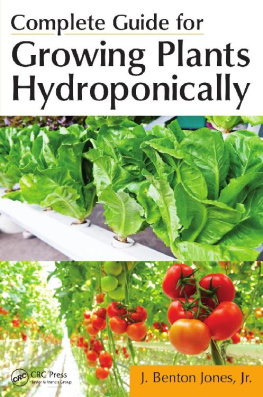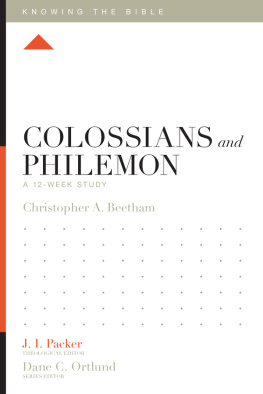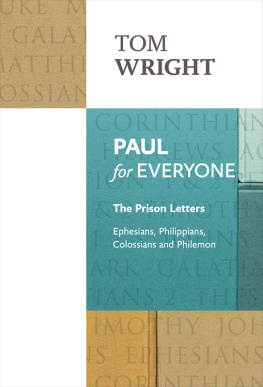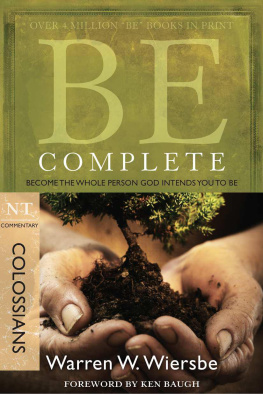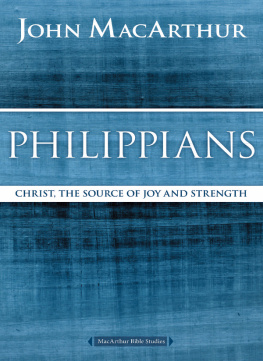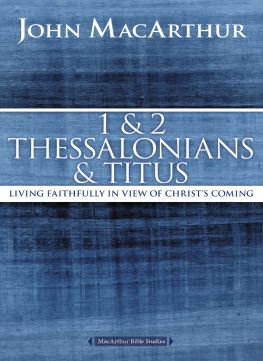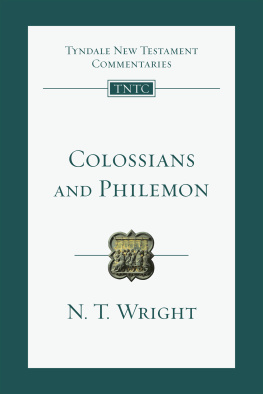COLOSSIANS AND PHILEMON
MACARTHUR BIBLE STUDIES
2007 by John MacArthur.
All rights reserved. No portion of this book may be reproduced, stored in a retrieval system, or transmitted in any form or by any meanselectronic, mechanical, photocopy, recording, or any otherexcept for brief quotations in printed reviews, without the prior permission of the publisher.
John MacArthur
Unleashing Gods Truth, One Verse at a Time
Unleashing Gods Truth, One Verse at a Time is a trademark of Grace to You. All rights reserved.
Published in Nashville, Tennessee, by Nelson Books, an imprint of Thomas Nelson. Nelson Books and Thomas Nelson are registered trademarks of HarperCollins Christian Publishing, Inc.
Nelson Books titles may be purchased in bulk for education, business, fundraising, or sales promotional use. For information, please email SpecialMarkets@ThomasNelson.com
Produced with the assistance of the Livingstone Corporation. Project staff include Jake Barton, Mary Horner Collins, and Andy Culbertson. Project editor: Len Woods
Scripture quotations marked NKJV are taken from The Holy Bible, New King James Version. 1979, 1980, 1982, 1992 Thomas Nelson, Inc.
Scripture quotations marked NASB are taken from the New American Standard Bible, 1960, 1962, 1963, 1968, 1971, 1972, 1973, 1975, 1977, 1995 by The Lockman Foundation. Used by permission.
Keys to the Text and Truth for Today material is taken from the following sources:
Colossians (electronic ed.). MacArthur New Testament Commentary Series. 1992, 1996 by John MacArthur. Published by Moody Press, Chicago, Illinois. Used by permission.
The Freedom and Power of Forgiveness (electronic ed.). 1998 by John MacArthur. Published by Crossway Books: Wheaton, Illinois. Used by permission.
The MacArthur Study Bible (electronic ed.). John MacArthur, General Editor. 1997 by Word Publishing. All rights reserved. Used by permission.
Matthew (electronic ed.). MacArthur New Testament Commentary Series. 1989 by John MacArthur. Published by Moody Press, Chicago, Illinois. Used by permission.
Nelsons New Illustrated Bible Dictionary. R. F. Youngblood, F. F. Bruce, R. K. Harrison, eds. 1995 by Thomas Nelson, Inc., Nashville, Tennessee.
Philemon (electronic ed.). MacArthur New Testament Commentary Series. 1992, 1996 by John MacArthur. Published by Moody Press, Chicago, Illinois. Used by permission.
Philippians. MacArthur New Testament Commentary Series. 2001 by John MacArthur. Published by Moody Press, Chicago, Illinois. Used by permission.
What Does the Bible Say About... ?: The Ultimate A to Z Resource. 2001 by Thomas Nelson, Inc., Nashville, Tennessee.
Cover Art by Holly Sharp Design
Interior Design and Composition by Joel Bartlett, Livingstone Corporation
ISBN 978-0-7180-3512-9
ISBN 978-0-7180-3531-0 (eBook)
15 16 17 18 19 RRD 6 5 4 3 2 1
CONTENTS
Colossians is named for the city of Colosse, where the church it was addressed to was located. It was also to be read in the neighboring church at Laodicea (4:16).
AUTHOR AND DATE
Paul is identified as the author at the beginning of the letter. The testimony of the early church, including such key figures as Irenaeus, Clement of Alexandria, Tertullian, Origen, and Eusebius, confirms that the opening claim is genuine. Additional evidence for Pauls authorship comes from the books close parallels with Philemon, which is universally accepted as having been written by Paul. Both were written (ca. AD 6062) while Paul was a prisoner in Rome (4:3, 10, 18; Philem. 910, 13, 23); plus the names of the same people (Timothy, Aristarchus, Archippus, Mark, Epaphras, Luke, Onesimus, and Demas) appear in both epistles, showing that both were written by the same author at about the same time.
BACKGROUND AND SETTING
Colosse was a city in Phrygia, in the Roman province of Asia (part of modern Turkey), about one hundred miles east of Ephesus, in the region of the seven churches of Revelation 13. The city lay alongside the Lycus River, not far from where it flowed into the Maender River. The Lycus Valley narrowed at Colosse to a width of about two miles, and Mt. Cadmus rose 8,000 feet above the city.
Colosse was a thriving city in the fifth century BC when the Persian king Xerxes (Ahasuerus, see Est. 1:1) marched through the region. Black wool and dyes (made from the nearby chalk deposits) were important products. In addition, the city was situated at the junction of the main north-south and east-west trade routes. By Pauls day, however, the main road had been rerouted through nearby Laodicea, thus bypassing Colosse and leading to its decline and the rise of the neighboring cities of Laodicea and Hierapolis.
Although Colosses population was mainly Gentile, there was a large Jewish settlement dating from the days of Antiochus the Great (223187 BC). Colosses mixed population of Jews and Gentiles manifested itself both in the composition of the church and in the heresy that plagued it, which contained elements of both Jewish legalism and pagan mysticism.
The church at Colosse began during Pauls three-year ministry at Ephesus (Acts 19). Its founder was not Paul, who had never been there (2:1), but Epaphras (1:57), who apparently was saved during a visit to Ephesus, then likely started the church in Colosse when he returned home. Several years after the Colossian church was founded, a dangerous heresy arose to threaten itone not identified with any particular historical system. It contained elements of what later became known as Gnosticism. Gnosticism held that God is good, but matter is evil; that Jesus Christ was merely one of a series of emanations descending from God and being less than God (a belief that led them to deny His true humanity); and that a secret, higher knowledge above Scripture was necessary for enlightenment and salvation. The Colossian heresy also embraced aspects of Jewish legalism, e.g., the necessity of circumcision for salvation, observance of the ceremonial rituals of the Old Testament law (dietary laws, festivals, Sabbaths), and rigid asceticism. It also called for the worship of angels and mystical experience. Epaphras was so concerned about this heresy that he made the long journey from Colosse to Rome (4:1213), where Paul was a prisoner.
This letter was written from prison in Rome (Acts 28:1631) sometime between AD 60 and 62 and is, therefore, referred to as a Prison Epistle (along with Ephesians, Philippians, and Philemon). It may have been composed almost contemporaneously with Ephesians and initially sent with that epistle (Eph. 6:2122; Col. 4:78). He wrote this letter to warn the Colossians against the heresy they faced. Paul sent the letter to them with Tychicus, who was accompanying the runaway slave Onesimus as he went back to his master, Philemon, a member of the Colossian church (4:79). Epaphras remained behind in Rome (see Philem. 23), perhaps to receive further instruction from Paul.
HISTORICAL AND THEOLOGICAL THEMES
Colossians contains teaching on several key areas of theology, including the deity of Christ (1:1520; 2:210), reconciliation (1:2023), redemption (1:1314; 2:1314; 3:911), election (3:12), forgiveness (3:13), and the nature of the church (1:18, 2425; 2:19; 3:11, 15). Also, as noted above, it refutes the heretical teaching that threatened the Colossian church (ch. 2).
INTERPRETIVE CHALLENGES
Those cults that deny Christs deity have seized upon the description of Him as the firstborn over all creation (1:15) as proof that He was a created being. Pauls statement that believers will be holy, and blameless, and above reproach if they continue in the faith (1:2223) has led some to teach that believers can lose their salvation. Some have argued for the existence of purgatory based on Pauls statement, I... fill up in my flesh what is lacking in the afflictions of Christ (1:24), while others see support for baptismal regeneration (2:12). The identity of the epistle from Laodicea (4:16) has also prompted much discussion. These issues will be treated in the notes.
Next page

